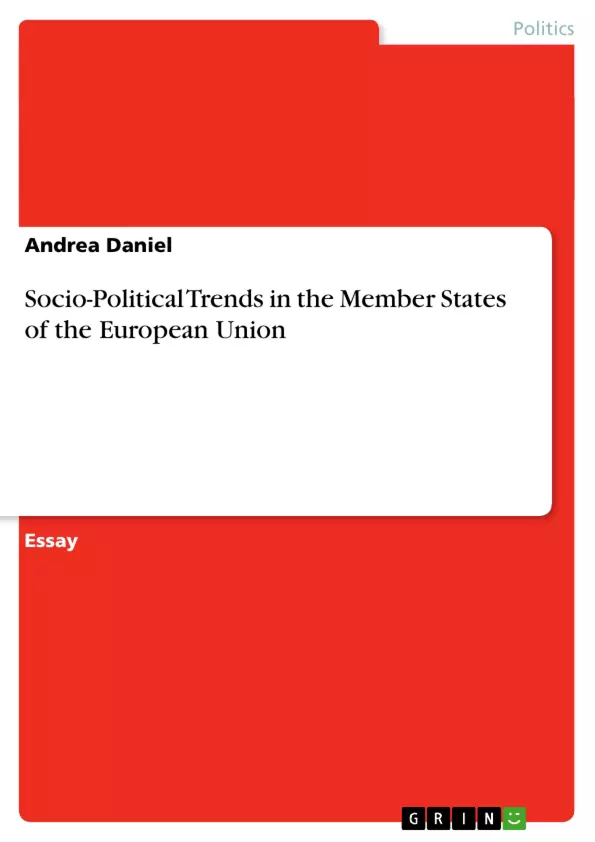The Essay's subject is a comparison of different models of welfare regimes in different Member States of the European Union. The comparison is based on the welfare state model of Esping-Anderson. Subsequently the Essay analyses the influence of the different national welfare regime models on the definition and forming of a European Social Model and a European Social Policy, using the model of "five dimensions of European Social Policy" as ell as discussing Leibfried's theses on this special field of European Policy
Inhaltsverzeichnis (Table of Contents)
- Welfare Systems in Europe
- The concept of "Welfare Regimes"
- Typologies of welfare regimes - purpose and significance
- The typology of Esping-Anderson – pros and cons
- A five dimensional ranking – significance for European policymakers
- The Theses of Stephan Leibfried – Pros and Cons
- Summary
- An example pro Leibfried's theses
- Examples contra Leibfried's theses
- The Future of European Socio Policy
Zielsetzung und Themenschwerpunkte (Objectives and Key Themes)
This text aims to provide a comparative analysis of welfare systems in Europe, exploring the concept of "welfare regimes" and their typologies. It focuses on understanding the historical and cultural factors that shape different welfare models and their implications for policy-making. Key themes explored include:- The concept and definition of "welfare regimes" across different societies
- The development and significance of welfare regime typologies
- The impact of historical, cultural, and economic factors on welfare regime development
- The role of government and private institutions in welfare provision
- The challenges and opportunities for the future of European socio-policy
Zusammenfassung der Kapitel (Chapter Summaries)
Welfare Systems in Europe
This chapter introduces the concept of "welfare regimes," exploring its multifaceted nature and variations in meaning across different societies. It discusses the importance of considering historical, cultural, and structural factors when defining and analyzing welfare systems. The chapter further defines a "welfare regime" as a comprehensive set of rules, principles, and practices that determine a society's approach to welfare provision.The concept of "Welfare Regimes"
This section provides a detailed explanation of the term "welfare regimes" and its significance for understanding the diverse approaches to welfare provision across European countries. It highlights the need for a comprehensive framework that encompasses both public and private actors, and considers the various dimensions that shape a society's welfare model.Typologies of welfare regimes - purpose and significance
This section explores the development of typologies in the analysis of welfare regimes. It highlights the use of empirical data and statistical analysis to compare different systems and identify key differences. The significance of these typologies lies in their contribution to the political discourse and informing decision-making regarding the future of welfare systems.The typology of Esping-Anderson – pros and cons
This section examines the typology developed by Esping-Anderson, outlining its strengths and weaknesses in understanding and comparing different welfare models.A five dimensional ranking – significance for European policymakers
This section explores the use of a five-dimensional ranking system in analyzing welfare regimes, highlighting its importance for European policymakers. It discusses the need for comprehensive and transparent ranking systems that take into account the diverse dimensions of welfare regimes.Schlüsselwörter (Keywords)
This text centers on the concepts of "welfare regimes" and "welfare systems" in a comparative European context. It focuses on analyzing the historical and cultural factors influencing different welfare models, including the role of government, private institutions, and societal values. The text also explores key themes such as typologies, rankings, and the future of European socio-policy. Relevant keywords include: welfare regimes, welfare systems, comparative analysis, historical factors, cultural factors, typologies, rankings, European social policy.
Excerpt out of 19 pages
- scroll top
- Quote paper
- Andrea Daniel (Author), 2008, Socio-Political Trends in the Member States of the European Union, Munich, GRIN Verlag, https://www.grin.com/document/131478
Look inside the ebook



